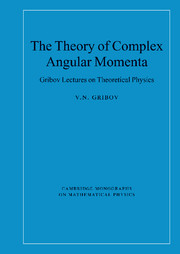Book contents
- Frontmatter
- Contents
- Foreword by Yuri Dokshitzer
- Introduction by Yuri Dokshitzer and Leonid Frankfurt
- 1 High energy hadron scattering
- 2 Physics of the t-channel and complex angular momenta
- 3 Singularities of partial waves and unitarity
- 4 Properties of Regge poles
- 5 Regge poles in high energy scattering
- 6 Scattering of particles with spin
- 7 Fermion Regge poles
- 8 Regge poles in perturbation theory
- 9 Reggeization of an electron
- 10 Vector field theory
- 11 Inconsistency of the Regge pole picture
- 12 Two-reggeon exchange and branch point singularities in the ℓ plane
- 13 Properties of Mandelstam branch singularities
- 14 Reggeon diagrams
- 15 Interacting reggeons
- 16 Reggeon field theory
- 17 The structure of weak and strong coupling solutions
- Appendix A Space-time description of the hadron interactions at high energies
- Appendix B Character of inclusive spectra and fluctuations produced in inelastic processes by multi-pomeron exchange
- Appendix C Theory of the heavy pomeron
- Index
Appendix A - Space-time description of the hadron interactions at high energies
Published online by Cambridge University Press: 06 January 2010
- Frontmatter
- Contents
- Foreword by Yuri Dokshitzer
- Introduction by Yuri Dokshitzer and Leonid Frankfurt
- 1 High energy hadron scattering
- 2 Physics of the t-channel and complex angular momenta
- 3 Singularities of partial waves and unitarity
- 4 Properties of Regge poles
- 5 Regge poles in high energy scattering
- 6 Scattering of particles with spin
- 7 Fermion Regge poles
- 8 Regge poles in perturbation theory
- 9 Reggeization of an electron
- 10 Vector field theory
- 11 Inconsistency of the Regge pole picture
- 12 Two-reggeon exchange and branch point singularities in the ℓ plane
- 13 Properties of Mandelstam branch singularities
- 14 Reggeon diagrams
- 15 Interacting reggeons
- 16 Reggeon field theory
- 17 The structure of weak and strong coupling solutions
- Appendix A Space-time description of the hadron interactions at high energies
- Appendix B Character of inclusive spectra and fluctuations produced in inelastic processes by multi-pomeron exchange
- Appendix C Theory of the heavy pomeron
- Index
Summary
Here we consider the strong and electromagnetic interactions of hadrons in a unified way. It is assumed that there exist point-like particles (partons) in the sense of quantum field theory and that a hadron with large momentum p consists of ∼ ln(p/µ) partons which have restricted transverse momenta, and longitudinal momenta which range from p to zero. The density of partons increases with the increase of the coupling constant. Since the probability of their recombination also increases, an equilibrium may be reached. In this lecture we will consider consequences of the hypothesis that the equilibrium really occurs. We demonstrate that it leads to constant total cross sections at high energies, and to the Bjorken scaling in the deep inelastic ep scattering. The asymptotic value of the total cross sections of hadron–hadron scattering turns out to be universal, while the cross sections of quasi-elastic scattering processes at zero angle tend to zero.
The multiplicity of the outgoing hadrons and their distributions in longitudinal momenta (rapidities) are also discussed.
Introduction
In this lecture we will try to describe electromagnetic and strong interactions of hadrons in the same framework which follows from general quantum field theory considerations without the introduction of quarks or other exotic objects.
We will assume that there exist point-like constituents in the sense of quantum field theory which are, however, strongly interacting. It is convenient to refer to these particles as partons.
- Type
- Chapter
- Information
- The Theory of Complex Angular MomentaGribov Lectures on Theoretical Physics, pp. 216 - 239Publisher: Cambridge University PressPrint publication year: 2003
- 1
- Cited by



